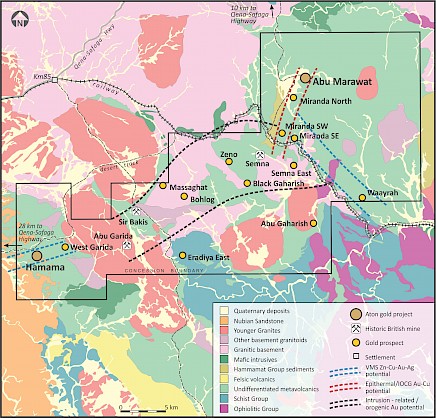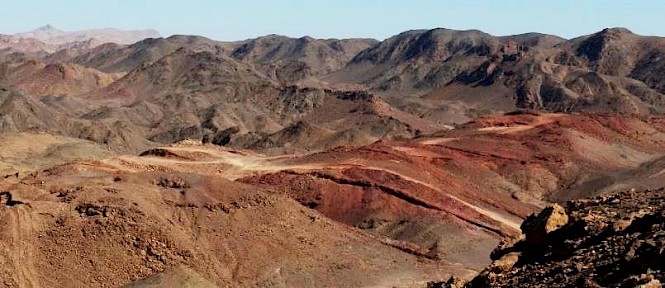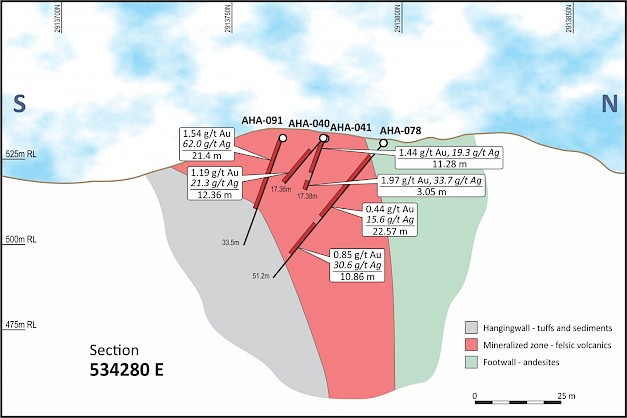Aton Announces Its Intention To Issue A Declaration Of Commerciality At The Hamama Project Within Its Abu Marawat Concession
November 20, 2017 - Aton Resources Inc. (the “Company”) (TSX-V: AAN) through its wholly owned subsidiary, Aton Mining Inc. and in accordance with article IX of its Abu Marawat Concession Agreement recognized as Law 96 of 2007, has today officially notified the Egyptian Mineral Resources Authority (EMRA) of its intention to make a declaration of commerciality at its Hamama Project and its intention to move towards its goal of construction of a producing mine on or before the end of year 2019. In this Aton, as per its Concession Agreement, will finalize its study in support of its commercial discovery on or before May 20, 2018. The Hamama Project study will encompass an open pit heap leach mining operation, with production commencing from the “gold oxide cap” at Hamama West.
Extension of Exploration License Period
The Company plans to continue its regional exploration program over the highly prospective Abu Marawat Concession (the “Concession”). In this regard and in recognition of the work being carried out to begin mining at Hamama, EMRA have agreed to grant Aton a two (2) year extension until July 31, 2020 of the Company’s exploration license covering the balance of the Abu Marawat Concession area not covered by the Hamama exploitation license in recognition of this accelerated intention to declare commerciality. EMRA and the Ministry of Petroleum (MOP) realize the long term nature of mineral exploration and development, far longer than in oil and gas. As Aton’s partner, EMRA are fully aware that this continued exploration work is critical to the potential development of the Abu Marawat Concession area, and that this will unlock the overall potential of the Concession, as well being a driver in the development of the economy and will increase employment in Upper Egypt.
“This is a historic day for Egypt and Aton, as we are only the second company, after Centamin back in 2001, to issue it’s intention to declare a commercial discovery, and we will now move towards our goal of building only the second new producing gold mine in Egypt in more than 90 years” says Mark Campbell, President and CEO of Aton Resources Inc. “Thanks to the forward thinking of EMRA, the 2 year extension to our exploration license they are granting allows Aton to continue carrying out the critical exploration that will lead to the potential development of the rest of the Abu Marawat Concession. We believe that this will enable Aton sufficient time to evaluate the potential to develop other gold deposits in the Concession area, which we are currently exploring, and to increase the overall production from the Concession in the longer term. This will not only greatly impact our local region and the new Golden Triangle Authority, but it will lead to increased employment and training, and will positively affect the overall economy of Upper Egypt”. To echo what The Minister of Petroleum and The Chairman of EMRA have recently stated, that the goal is now to encourage investment to build the mining industry here and make it a ‘Pillar of the Egyptian Economy’ and one that competes in the global mining industry. Their granting us this extension is certainly a step in that direction.”
Hamama Project
The Hamama Project refers to the Hamama Area, which encompasses the Hamama West, Hamama Central, Hamama East zones and the newly discovered West Garida zone (see Fig. 1). The heap leach pad and circuit will be located in easy access of all zones and production will begin on the “gold oxide cap” at Hamama West.

Figure 1: Location map of the Hamama Project, showing the Hamama West, Central and East and the West Garida zones (modified from Google Earth)
Abu Marawat Concession
The Company has identified mineral resources at the Hamama West and Abu Marawat deposits (see news releases dated January 24, 2017 and April 16, 2012 respectively) within its Abu Marawat Concession (see Fig. 2). The Concession is over 738 km2 in size, and extends 45 km east to west. Within the Concession there are also 2 historic British gold mines, which were worked during the early 1900’s at Semna and Sir Bakis, and a British tungsten mine at Abu Garida, which was worked during the middle of the 20th Century. There are also many ancient workings in the Concession, both alluvial/placer, and primary lode gold workings, dating back to as early as the New Kingdom period, more than 3,000 years ago.
The Concession is located within the Central Eastern Desert which is located in the northern part of the Nubian or African portion of the Arabian-Nubian Shield (the “ANS”). The ANS is host to several world class gold and VMS deposits, including Centamin’s Sukari gold mine, 200 km to the south of Hamama, the Mahd adh Dahab gold and Jabal Sayid copper mines in Saudi Arabia, the Hassai and Hadal-Awatib VMS deposits in Sudan, and the Bisha copper-gold-zinc mine in Eritrea.

Figure 2: Regional geology of the Abu Marawat Concession, showing the locations of the Hamama and Abu Marawat projects, historic mines, and exploration prospects
The geology in the Concession area consists of a series of late Neoproterozoic age volcano-sedimentary sequences, and granitic basement or older “grey” granites, which formed in island arc volcanic settings. Ultramafic rocks also outcrop in the southeastern part of the Concession, and were formed in oceanic crust, and later thrust into and accreted onto the island arc sequences. These older rocks have been intruded by a series of distinctive late, pink “Younger” or Gattarian granites, which are spatially associated with much of the gold mineralization in the Eastern Desert of Egypt.
The Company has identified numerous different styles of gold mineralization within the Concession, and has been actively exploring regional prospects during 2017. At Hamama the mineralization consists of hybrid VMS-epithermal gold-silver-zinc mineralization, while at Abu Marawat the mineralization occurs in epithermal style polymetallic gold-silver-copper-zinc veins. During 2017 the Company has also discovered new VMS style mineralization at Waayrah (see news release dated June 27, 2017), as well as identifying a belt possibly favorable for VMS mineralization extending from Waayrah in the south-east to Miranda SE, and potentially further north to the Abu Marawat deposit. Extending south-west from the Abu Marawat deposit to Miranda SW is a zone of intensely altered largely felsic volcanic rocks which host copper and gold mineralization. This Abu Marawat-Miranda corridor has been identified as having potential to host further epithermal and potentially IOCG vein styles of mineralization.
The Company has also identified a large zone that has the potential to host reduced intrusion related (“IR”) gold mineralization, predominantly hosted in granitic rocks, and spatially related to the Younger Granites, extending east from Sir Bakis in the west to Semna East, and including the Bohlog, Massaghat, and Zeno prospects (see news releases dated September 13, 2017 and June 7, 2017). This zone also hosts structurally controlled or orogenic gold mineralization at Semna and Black Gaharish. The high grade vein at the Semna mine was the widest mined during the British era of mining in Egypt, and reaches 6m in width. The Company has also identified high grade structurally controlled or orogenic style gold mineralization at Abu Gaharish (see news release dated June 7, 2017), and is currently investigating very extensive ancient workings recently discovered at Eradiya East, both of which are again spatially related to Younger Granite intrusives. The Company has also recently discovered high grade quartz veins at West Garida, which will be included in the Hamama Area (see news release dated October 17, 2017)
The Company has just commenced a deep ground penetrating radar (GPR) survey, which is being undertaken by Terravision Radar, at the Sir Bakis, Waayrah, Miranda South, Abu Gaharish, Semna, Bohlog, and Eradiya East prospects.
The Hamama West Deposit
The Hamama West deposit is one of a series of three contiguous zones hosting stratabound gold-silver-zinc mineralization (Hamama West, Hamama Central, and Hamama East), which along with the Western Carbonate zone occur within a silicacarbonate unit which constitutes the “mineralized horizon”, and is mineralized at surface over an exposed strike length of approximately 3 km (see Fig. 3). The high grade West Garida quartz vein mineralization is located in felsic and intermediate volcanic rocks in the structural footwall of the mineralized silica-carbonate horizon. Of these zones only Hamama West has been significantly tested, and only very limited drilling has been undertaken at Hamama Central and Hamama East to date.

Figure 3: Schematic geology of the Hamama area
In January 2017 the Company announced the maiden resource estimate for Hamama West (see news release dated January 24, 2017). Hamama West hosts an Inferred Mineral Resource of 341,000 ounces gold equivalent (“AuEq”) (see Table 1) and an Indicated Mineral Resource of 137,000 ounces AuEq (see Table 2). The Company has also undertaken further successful diamond drilling at Hamama West during 2017, the results which will be incorporated into the next mineral resource estimate at Hamama West.

- Mineral resources are not mineral reserves and do not demonstrate economic viability.
- All tonnage, grade and ounces have been rounded and minor discrepancies in additive totals may occur.
- Weathering classification is based on visual assessment of drill core by geologists and does not represent a definitive geometallurgical classification.
- The mineral resource are quoted at a minimum cut-off grade of 0.5 g/t Au equivalent, where the silver contribution has been based on a silver:gold ratio of 70:1.
- Reasonable prospects of eventual economic extraction have been determined using assumptions based upon some African open pit projects of similar scale, and have included a gold price of US$1250/oz, generic open pit mining and processing costs and generic metallurgical recoveries for gold and silver. At this stage of the property’s development, no detailed economic, mining or metallurgical studies have been completed. The classification does not infer that mineral resources demonstrate economic viability.
At Hamama West the mineralization occurs as an overturned stratiform and stratabound tabular deposit, hosted within a silica-carbonate rock unit, associated with altered felsic tuffaceous rocks. The footwall stratigraphy consists of altered and weakly mineralized andesites. The hangingwall is dominated by unmineralized tuffs and argillites, which contain numerous thin beds of jasper. The current interpretation is that the Hamama West deposit displays many of the characteristics of the ‘VMS-epithermal hybrid’ sub-class of VMS deposits, which are essentially the shallow marine equivalent of subaerial epithermal systems.
The Hamama West deposit comprises primary hypogene sulphide mineralization overlain by an oxidized zone of gold-bearing gossan or a “gold oxide cap” (see Fig. 4). Outcrop mapping and drilling have defined the deposit to date with a strike length of approximately 700m, and an average outcropping width of around 60m at surface. Drilling has intersected mineralization to a depth of 275m below surface, to date.

Figure 4: Looking north-east to the Hamama West “gold oxide cap”
The “gold oxide cap” is characterized as a 30-40m thick gossanous zone of weathered and oxidized material. This “gold oxide cap” is quite variable, consisting of zones of reddish-brown iron oxide-rich material (as seen in Fig. 4), and other zones of less weathered greyish-brown silica-carbonate-iron oxide rock. Gold and silver are typically quite strongly enriched in the uppermost 3-5m of the profile, but occur throughout the weathered “gold oxide cap” (see Fig. 5).

Figure 5: Cross-section 534280E, showing representative grades through the “gold oxide cap”
About Aton Resources Inc.
Aton Resources Inc. (AAN: TSX-V) is focused on its 100% owned Abu Marawat Concession (“Abu Marawat”), located in Egypt’s Arabian-Nubian Shield, approximately 200 km north of Centamin’s Sukari gold mine. Aton has identified a 40 km long gold mineralized trend at Abu Marawat, anchored by the Hamama deposit in the west and the Abu Marawat deposit in the east, containing numerous gold exploration targets, including three historic British mines. Aton has identified several distinct geological trends within Abu Marawat, which display potential for the development of intrusion related and orogenic gold mineralization, VMS precious and base metal mineralization, and epithermal-IOCG precious and base metal mineralization. Abu Marawat is over 738 km2 in size and is located in an area of excellent infrastructure; a four-lane highway, a 220kV power line, and a water pipeline are in close proximity.
Qualified Person
The technical information contained in this News Release was prepared by Roderick Cavaney BSc, MSc (hons), MSc (Mining & Exploration Geology), FAusIMM, SEG, GSA, SME, Vice President, Exploration, of Aton Resources Inc. Mr. Cavaney is a qualified person (QP) under National Instrument 43-101 Standards of Disclosure for Mineral Projects.
For further information regarding Aton Resources Inc., please visit us at www.atonresources.com or contact:
Mark Campbell
President and Chief Executive Officer
Tel: +1-936-689-2589
Email: mcampbell@atonresources.com
Forward Looking Statements.
Certain information contained in this press release constitutes “forward-looking information”, within the meaning of Canadian legislation. Generally, these forwardlooking statements can be identified by the use of forward-looking terminology such as “will try”, “with the goal of” “intends”, or variations of such words and phrases or statements that certain actions, events or results “may”, “could”, or “potentially” could occur. Forward looking statements contained in this press release may include statements regarding the future operating or financial performance of the Company which involve known and unknown risks and uncertainties which may not prove to be accurate. Actual results and outcomes may differ materially from what is expressed or forecasted in these forward-looking statements. Such statements are qualified in their entirety by the inherent risks and uncertainties surrounding future expectations. Among those factors which could cause actual results to differ materially are the following: market conditions and other risk factors listed from time to time in our reports filed with Canadian securities regulators on SEDAR at www.sedar.com. The forward-looking statements included in this press release are made as of the date of this press release and the Company disclaims any intention or obligation to update or revise any forwardlooking statements, whether as a result of new information, future events or otherwise, except as expressly required by applicable securities legislation.
The Company’s most recent technical report, “Hamama West Deposit, Abu Marawat Concession, Arab Republic of Egypt” dated January 24, 2017 and prepared for the Company by Matt Bampton, B.Sc. (Hons.) M.Sc. MAusIMM MAIG of Cube Consulting Pty. Ltd. is available under the Company’s profile at www.sedar.com, and discloses the most recent resource estimates for Hamama West and Abu Marawat, which are comprised of indicated and inferred mineral resources (in the case of Hamama West) and inferred mineral resources (in the case of Abu Marawat). Neither Hamama West nor Abu Marawat presently have any mineral reserves, and the Company has not obtained a either a preliminary economic assessment or a technical report demonstrating the economic and technical viability of any potential mining operations at either project. There is uncertainty as to whether the Company will be able to produce gold at either of its projects.
